Critical Appraisal of a Nursing Research Article: Conway et al. (2012)
VerifiedAdded on 2020/04/13
|6
|1619
|360
Report
AI Summary
This report presents a critical appraisal of the research article by Conway et al. (2012) focusing on the issues and challenges of nurse-administered procedural sedation and analgesia in cardiac catheterization laboratories. The study employed a qualitative methodology, utilizing interviews with senior nurses to explore their perspectives on procedural sedation and analgesia (PSA) practices. The appraisal, conducted using the Critical Appraisal Skills Programme (CASP) tool, examines the study's methodology, including its exploratory design, participant recruitment, data collection through semi-structured interviews, and thematic analysis approach. The report highlights the study's findings, such as concerns about the lack of access to anaesthetists, challenges in patient monitoring, limitations of sedative medications, and the impact of procedure complexity on sedation requirements. It also discusses the study's limitations, including the sample size and the potential for context-dependent findings. The report concludes by emphasizing the relevance of the research to clinical practice and the need for improved strategies to support nurses in managing PSA.
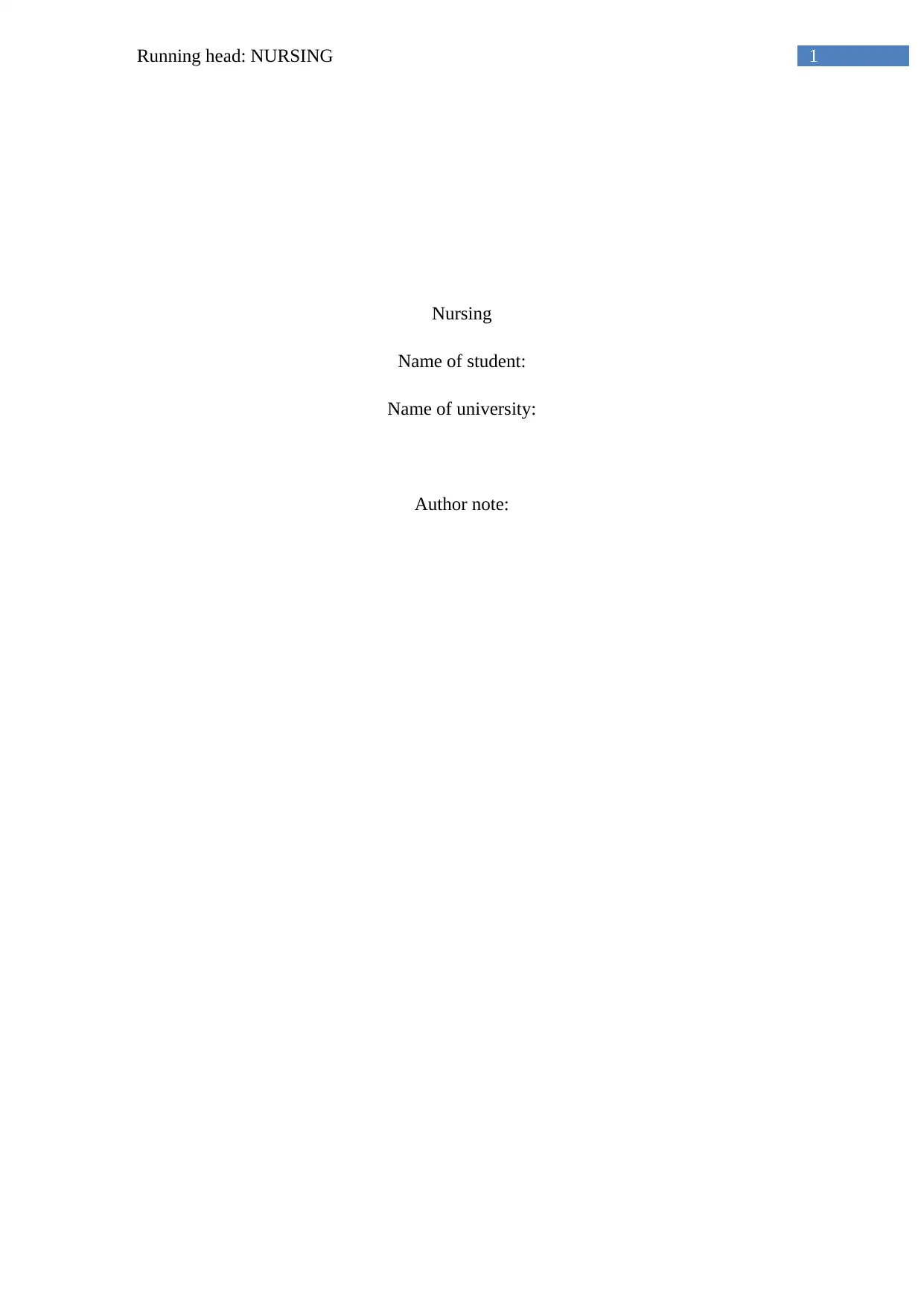
1Running head: NURSING
Nursing
Name of student:
Name of university:
Author note:
Nursing
Name of student:
Name of university:
Author note:
Paraphrase This Document
Need a fresh take? Get an instant paraphrase of this document with our AI Paraphraser
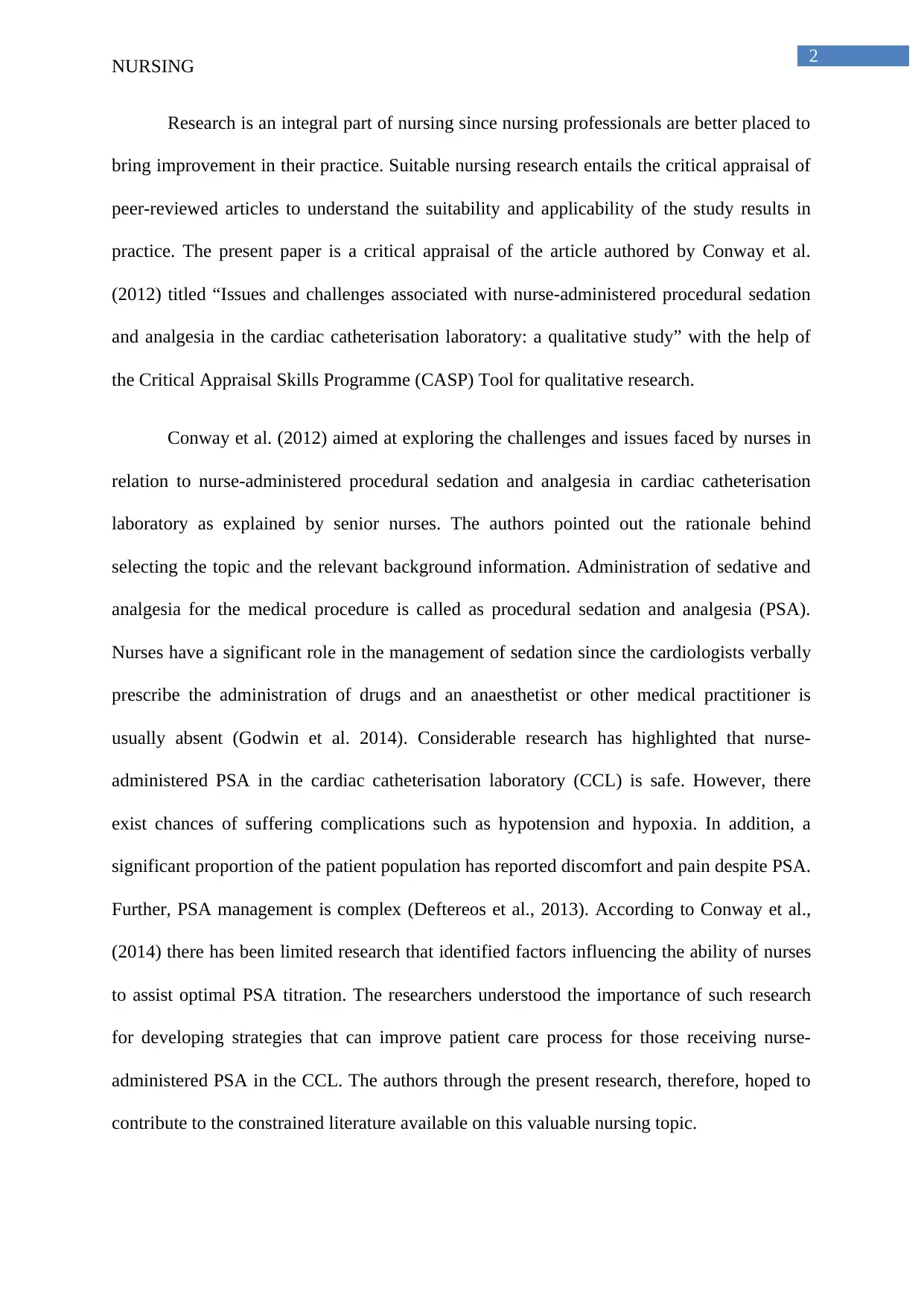
2
NURSING
Research is an integral part of nursing since nursing professionals are better placed to
bring improvement in their practice. Suitable nursing research entails the critical appraisal of
peer-reviewed articles to understand the suitability and applicability of the study results in
practice. The present paper is a critical appraisal of the article authored by Conway et al.
(2012) titled “Issues and challenges associated with nurse-administered procedural sedation
and analgesia in the cardiac catheterisation laboratory: a qualitative study” with the help of
the Critical Appraisal Skills Programme (CASP) Tool for qualitative research.
Conway et al. (2012) aimed at exploring the challenges and issues faced by nurses in
relation to nurse-administered procedural sedation and analgesia in cardiac catheterisation
laboratory as explained by senior nurses. The authors pointed out the rationale behind
selecting the topic and the relevant background information. Administration of sedative and
analgesia for the medical procedure is called as procedural sedation and analgesia (PSA).
Nurses have a significant role in the management of sedation since the cardiologists verbally
prescribe the administration of drugs and an anaesthetist or other medical practitioner is
usually absent (Godwin et al. 2014). Considerable research has highlighted that nurse-
administered PSA in the cardiac catheterisation laboratory (CCL) is safe. However, there
exist chances of suffering complications such as hypotension and hypoxia. In addition, a
significant proportion of the patient population has reported discomfort and pain despite PSA.
Further, PSA management is complex (Deftereos et al., 2013). According to Conway et al.,
(2014) there has been limited research that identified factors influencing the ability of nurses
to assist optimal PSA titration. The researchers understood the importance of such research
for developing strategies that can improve patient care process for those receiving nurse-
administered PSA in the CCL. The authors through the present research, therefore, hoped to
contribute to the constrained literature available on this valuable nursing topic.
NURSING
Research is an integral part of nursing since nursing professionals are better placed to
bring improvement in their practice. Suitable nursing research entails the critical appraisal of
peer-reviewed articles to understand the suitability and applicability of the study results in
practice. The present paper is a critical appraisal of the article authored by Conway et al.
(2012) titled “Issues and challenges associated with nurse-administered procedural sedation
and analgesia in the cardiac catheterisation laboratory: a qualitative study” with the help of
the Critical Appraisal Skills Programme (CASP) Tool for qualitative research.
Conway et al. (2012) aimed at exploring the challenges and issues faced by nurses in
relation to nurse-administered procedural sedation and analgesia in cardiac catheterisation
laboratory as explained by senior nurses. The authors pointed out the rationale behind
selecting the topic and the relevant background information. Administration of sedative and
analgesia for the medical procedure is called as procedural sedation and analgesia (PSA).
Nurses have a significant role in the management of sedation since the cardiologists verbally
prescribe the administration of drugs and an anaesthetist or other medical practitioner is
usually absent (Godwin et al. 2014). Considerable research has highlighted that nurse-
administered PSA in the cardiac catheterisation laboratory (CCL) is safe. However, there
exist chances of suffering complications such as hypotension and hypoxia. In addition, a
significant proportion of the patient population has reported discomfort and pain despite PSA.
Further, PSA management is complex (Deftereos et al., 2013). According to Conway et al.,
(2014) there has been limited research that identified factors influencing the ability of nurses
to assist optimal PSA titration. The researchers understood the importance of such research
for developing strategies that can improve patient care process for those receiving nurse-
administered PSA in the CCL. The authors through the present research, therefore, hoped to
contribute to the constrained literature available on this valuable nursing topic.
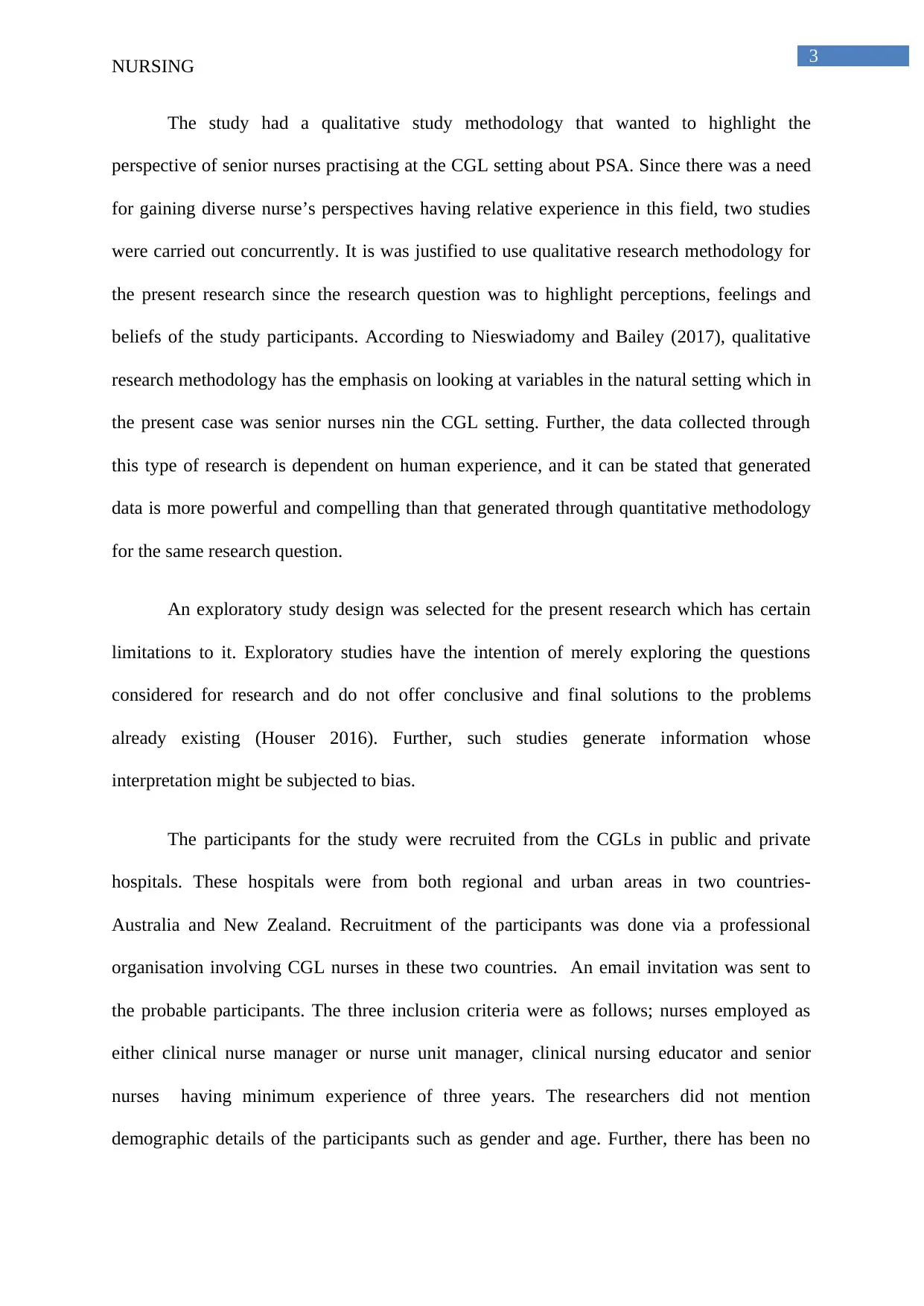
3
NURSING
The study had a qualitative study methodology that wanted to highlight the
perspective of senior nurses practising at the CGL setting about PSA. Since there was a need
for gaining diverse nurse’s perspectives having relative experience in this field, two studies
were carried out concurrently. It is was justified to use qualitative research methodology for
the present research since the research question was to highlight perceptions, feelings and
beliefs of the study participants. According to Nieswiadomy and Bailey (2017), qualitative
research methodology has the emphasis on looking at variables in the natural setting which in
the present case was senior nurses nin the CGL setting. Further, the data collected through
this type of research is dependent on human experience, and it can be stated that generated
data is more powerful and compelling than that generated through quantitative methodology
for the same research question.
An exploratory study design was selected for the present research which has certain
limitations to it. Exploratory studies have the intention of merely exploring the questions
considered for research and do not offer conclusive and final solutions to the problems
already existing (Houser 2016). Further, such studies generate information whose
interpretation might be subjected to bias.
The participants for the study were recruited from the CGLs in public and private
hospitals. These hospitals were from both regional and urban areas in two countries-
Australia and New Zealand. Recruitment of the participants was done via a professional
organisation involving CGL nurses in these two countries. An email invitation was sent to
the probable participants. The three inclusion criteria were as follows; nurses employed as
either clinical nurse manager or nurse unit manager, clinical nursing educator and senior
nurses having minimum experience of three years. The researchers did not mention
demographic details of the participants such as gender and age. Further, there has been no
NURSING
The study had a qualitative study methodology that wanted to highlight the
perspective of senior nurses practising at the CGL setting about PSA. Since there was a need
for gaining diverse nurse’s perspectives having relative experience in this field, two studies
were carried out concurrently. It is was justified to use qualitative research methodology for
the present research since the research question was to highlight perceptions, feelings and
beliefs of the study participants. According to Nieswiadomy and Bailey (2017), qualitative
research methodology has the emphasis on looking at variables in the natural setting which in
the present case was senior nurses nin the CGL setting. Further, the data collected through
this type of research is dependent on human experience, and it can be stated that generated
data is more powerful and compelling than that generated through quantitative methodology
for the same research question.
An exploratory study design was selected for the present research which has certain
limitations to it. Exploratory studies have the intention of merely exploring the questions
considered for research and do not offer conclusive and final solutions to the problems
already existing (Houser 2016). Further, such studies generate information whose
interpretation might be subjected to bias.
The participants for the study were recruited from the CGLs in public and private
hospitals. These hospitals were from both regional and urban areas in two countries-
Australia and New Zealand. Recruitment of the participants was done via a professional
organisation involving CGL nurses in these two countries. An email invitation was sent to
the probable participants. The three inclusion criteria were as follows; nurses employed as
either clinical nurse manager or nurse unit manager, clinical nursing educator and senior
nurses having minimum experience of three years. The researchers did not mention
demographic details of the participants such as gender and age. Further, there has been no
⊘ This is a preview!⊘
Do you want full access?
Subscribe today to unlock all pages.

Trusted by 1+ million students worldwide
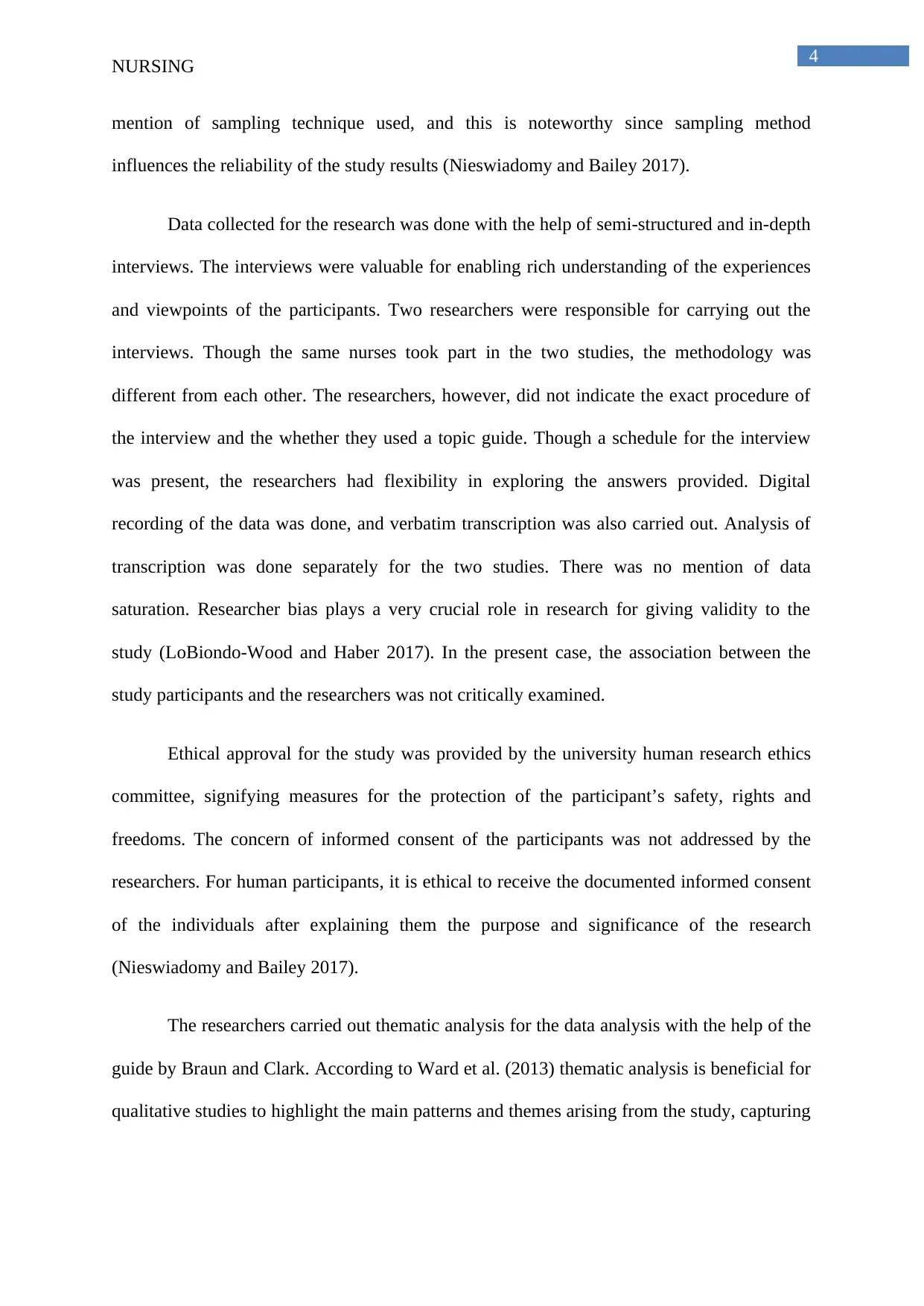
4
NURSING
mention of sampling technique used, and this is noteworthy since sampling method
influences the reliability of the study results (Nieswiadomy and Bailey 2017).
Data collected for the research was done with the help of semi-structured and in-depth
interviews. The interviews were valuable for enabling rich understanding of the experiences
and viewpoints of the participants. Two researchers were responsible for carrying out the
interviews. Though the same nurses took part in the two studies, the methodology was
different from each other. The researchers, however, did not indicate the exact procedure of
the interview and the whether they used a topic guide. Though a schedule for the interview
was present, the researchers had flexibility in exploring the answers provided. Digital
recording of the data was done, and verbatim transcription was also carried out. Analysis of
transcription was done separately for the two studies. There was no mention of data
saturation. Researcher bias plays a very crucial role in research for giving validity to the
study (LoBiondo-Wood and Haber 2017). In the present case, the association between the
study participants and the researchers was not critically examined.
Ethical approval for the study was provided by the university human research ethics
committee, signifying measures for the protection of the participant’s safety, rights and
freedoms. The concern of informed consent of the participants was not addressed by the
researchers. For human participants, it is ethical to receive the documented informed consent
of the individuals after explaining them the purpose and significance of the research
(Nieswiadomy and Bailey 2017).
The researchers carried out thematic analysis for the data analysis with the help of the
guide by Braun and Clark. According to Ward et al. (2013) thematic analysis is beneficial for
qualitative studies to highlight the main patterns and themes arising from the study, capturing
NURSING
mention of sampling technique used, and this is noteworthy since sampling method
influences the reliability of the study results (Nieswiadomy and Bailey 2017).
Data collected for the research was done with the help of semi-structured and in-depth
interviews. The interviews were valuable for enabling rich understanding of the experiences
and viewpoints of the participants. Two researchers were responsible for carrying out the
interviews. Though the same nurses took part in the two studies, the methodology was
different from each other. The researchers, however, did not indicate the exact procedure of
the interview and the whether they used a topic guide. Though a schedule for the interview
was present, the researchers had flexibility in exploring the answers provided. Digital
recording of the data was done, and verbatim transcription was also carried out. Analysis of
transcription was done separately for the two studies. There was no mention of data
saturation. Researcher bias plays a very crucial role in research for giving validity to the
study (LoBiondo-Wood and Haber 2017). In the present case, the association between the
study participants and the researchers was not critically examined.
Ethical approval for the study was provided by the university human research ethics
committee, signifying measures for the protection of the participant’s safety, rights and
freedoms. The concern of informed consent of the participants was not addressed by the
researchers. For human participants, it is ethical to receive the documented informed consent
of the individuals after explaining them the purpose and significance of the research
(Nieswiadomy and Bailey 2017).
The researchers carried out thematic analysis for the data analysis with the help of the
guide by Braun and Clark. According to Ward et al. (2013) thematic analysis is beneficial for
qualitative studies to highlight the main patterns and themes arising from the study, capturing
Paraphrase This Document
Need a fresh take? Get an instant paraphrase of this document with our AI Paraphraser
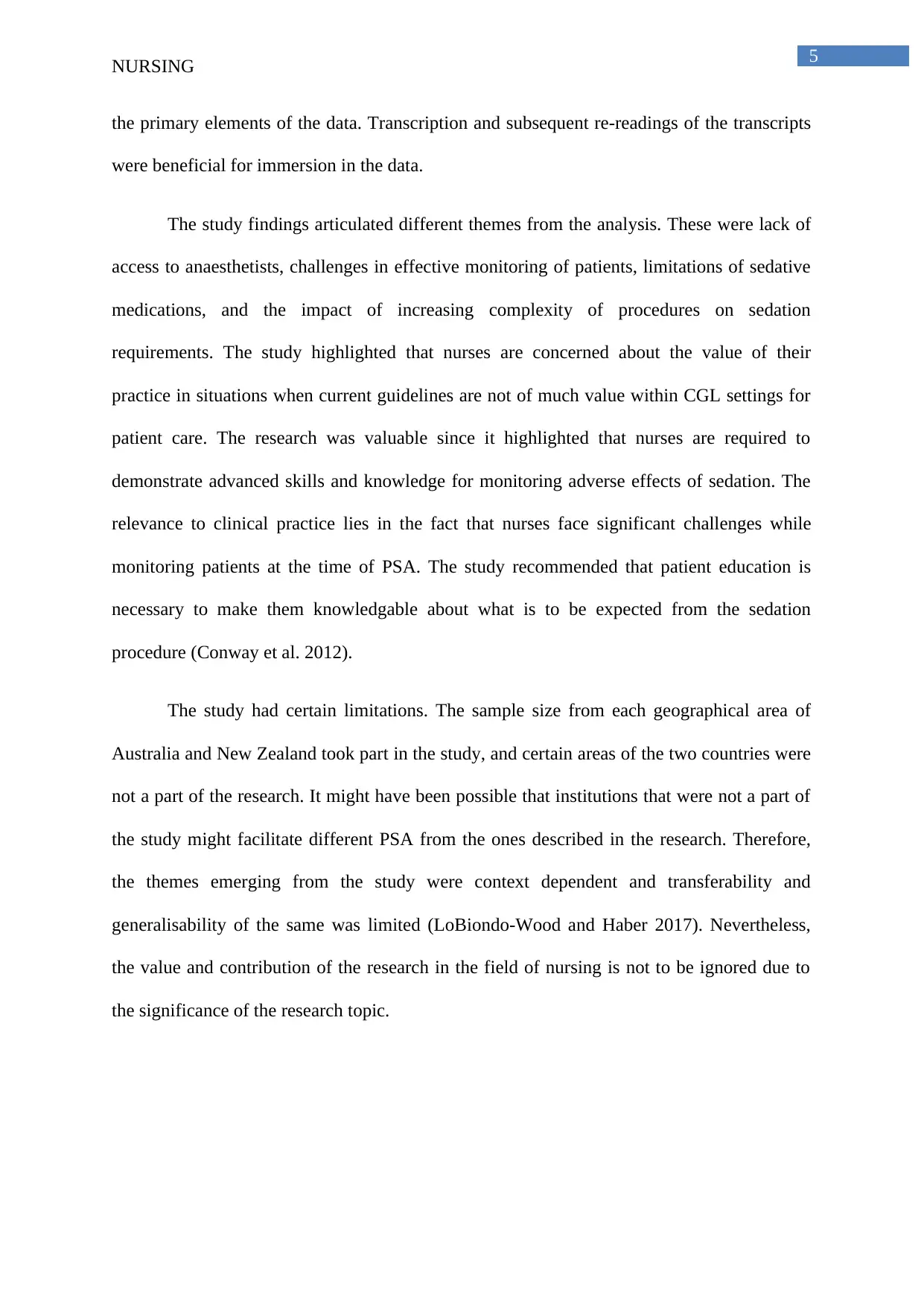
5
NURSING
the primary elements of the data. Transcription and subsequent re-readings of the transcripts
were beneficial for immersion in the data.
The study findings articulated different themes from the analysis. These were lack of
access to anaesthetists, challenges in effective monitoring of patients, limitations of sedative
medications, and the impact of increasing complexity of procedures on sedation
requirements. The study highlighted that nurses are concerned about the value of their
practice in situations when current guidelines are not of much value within CGL settings for
patient care. The research was valuable since it highlighted that nurses are required to
demonstrate advanced skills and knowledge for monitoring adverse effects of sedation. The
relevance to clinical practice lies in the fact that nurses face significant challenges while
monitoring patients at the time of PSA. The study recommended that patient education is
necessary to make them knowledgable about what is to be expected from the sedation
procedure (Conway et al. 2012).
The study had certain limitations. The sample size from each geographical area of
Australia and New Zealand took part in the study, and certain areas of the two countries were
not a part of the research. It might have been possible that institutions that were not a part of
the study might facilitate different PSA from the ones described in the research. Therefore,
the themes emerging from the study were context dependent and transferability and
generalisability of the same was limited (LoBiondo-Wood and Haber 2017). Nevertheless,
the value and contribution of the research in the field of nursing is not to be ignored due to
the significance of the research topic.
NURSING
the primary elements of the data. Transcription and subsequent re-readings of the transcripts
were beneficial for immersion in the data.
The study findings articulated different themes from the analysis. These were lack of
access to anaesthetists, challenges in effective monitoring of patients, limitations of sedative
medications, and the impact of increasing complexity of procedures on sedation
requirements. The study highlighted that nurses are concerned about the value of their
practice in situations when current guidelines are not of much value within CGL settings for
patient care. The research was valuable since it highlighted that nurses are required to
demonstrate advanced skills and knowledge for monitoring adverse effects of sedation. The
relevance to clinical practice lies in the fact that nurses face significant challenges while
monitoring patients at the time of PSA. The study recommended that patient education is
necessary to make them knowledgable about what is to be expected from the sedation
procedure (Conway et al. 2012).
The study had certain limitations. The sample size from each geographical area of
Australia and New Zealand took part in the study, and certain areas of the two countries were
not a part of the research. It might have been possible that institutions that were not a part of
the study might facilitate different PSA from the ones described in the research. Therefore,
the themes emerging from the study were context dependent and transferability and
generalisability of the same was limited (LoBiondo-Wood and Haber 2017). Nevertheless,
the value and contribution of the research in the field of nursing is not to be ignored due to
the significance of the research topic.
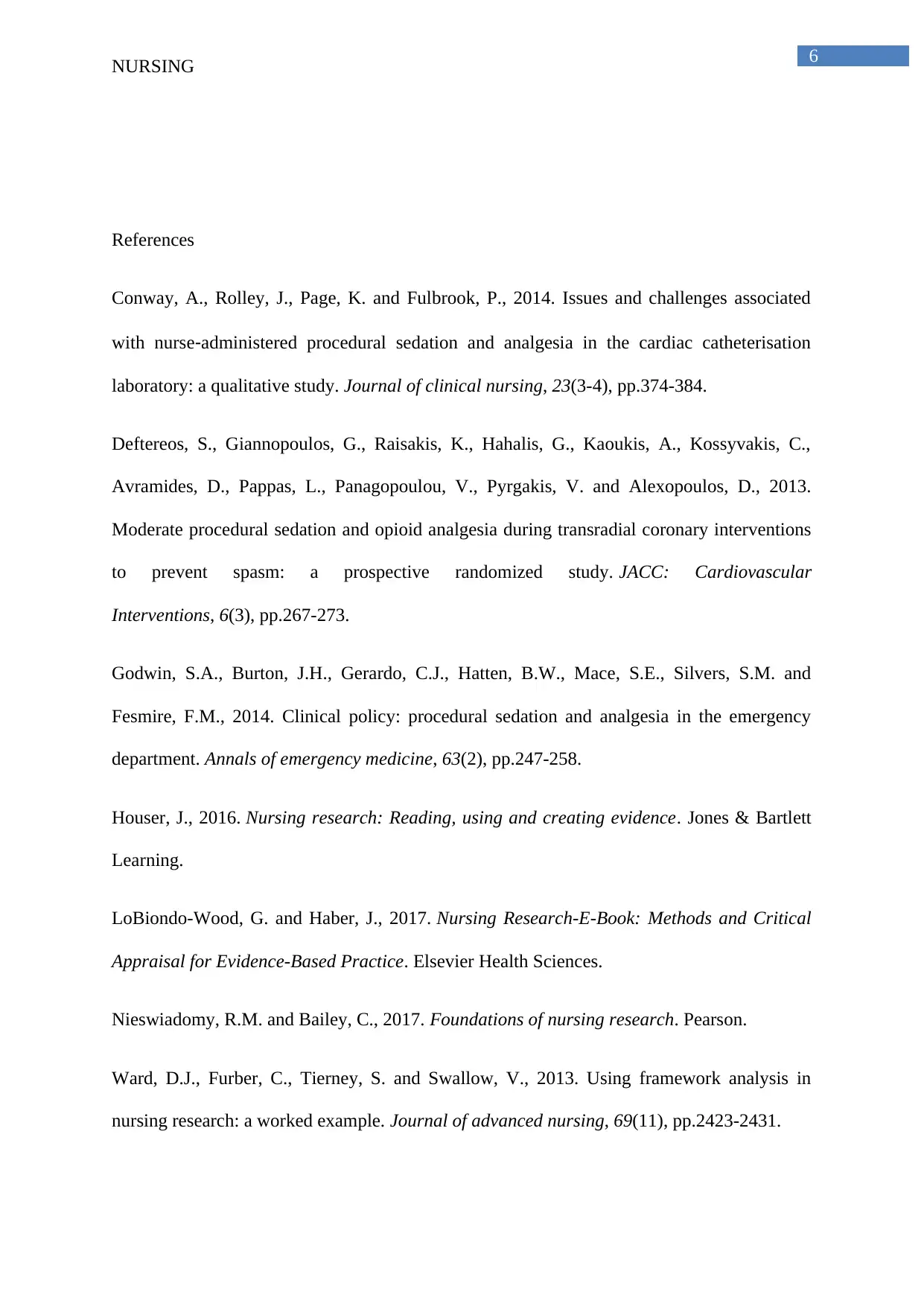
6
NURSING
References
Conway, A., Rolley, J., Page, K. and Fulbrook, P., 2014. Issues and challenges associated
with nurse‐administered procedural sedation and analgesia in the cardiac catheterisation
laboratory: a qualitative study. Journal of clinical nursing, 23(3-4), pp.374-384.
Deftereos, S., Giannopoulos, G., Raisakis, K., Hahalis, G., Kaoukis, A., Kossyvakis, C.,
Avramides, D., Pappas, L., Panagopoulou, V., Pyrgakis, V. and Alexopoulos, D., 2013.
Moderate procedural sedation and opioid analgesia during transradial coronary interventions
to prevent spasm: a prospective randomized study. JACC: Cardiovascular
Interventions, 6(3), pp.267-273.
Godwin, S.A., Burton, J.H., Gerardo, C.J., Hatten, B.W., Mace, S.E., Silvers, S.M. and
Fesmire, F.M., 2014. Clinical policy: procedural sedation and analgesia in the emergency
department. Annals of emergency medicine, 63(2), pp.247-258.
Houser, J., 2016. Nursing research: Reading, using and creating evidence. Jones & Bartlett
Learning.
LoBiondo-Wood, G. and Haber, J., 2017. Nursing Research-E-Book: Methods and Critical
Appraisal for Evidence-Based Practice. Elsevier Health Sciences.
Nieswiadomy, R.M. and Bailey, C., 2017. Foundations of nursing research. Pearson.
Ward, D.J., Furber, C., Tierney, S. and Swallow, V., 2013. Using framework analysis in
nursing research: a worked example. Journal of advanced nursing, 69(11), pp.2423-2431.
NURSING
References
Conway, A., Rolley, J., Page, K. and Fulbrook, P., 2014. Issues and challenges associated
with nurse‐administered procedural sedation and analgesia in the cardiac catheterisation
laboratory: a qualitative study. Journal of clinical nursing, 23(3-4), pp.374-384.
Deftereos, S., Giannopoulos, G., Raisakis, K., Hahalis, G., Kaoukis, A., Kossyvakis, C.,
Avramides, D., Pappas, L., Panagopoulou, V., Pyrgakis, V. and Alexopoulos, D., 2013.
Moderate procedural sedation and opioid analgesia during transradial coronary interventions
to prevent spasm: a prospective randomized study. JACC: Cardiovascular
Interventions, 6(3), pp.267-273.
Godwin, S.A., Burton, J.H., Gerardo, C.J., Hatten, B.W., Mace, S.E., Silvers, S.M. and
Fesmire, F.M., 2014. Clinical policy: procedural sedation and analgesia in the emergency
department. Annals of emergency medicine, 63(2), pp.247-258.
Houser, J., 2016. Nursing research: Reading, using and creating evidence. Jones & Bartlett
Learning.
LoBiondo-Wood, G. and Haber, J., 2017. Nursing Research-E-Book: Methods and Critical
Appraisal for Evidence-Based Practice. Elsevier Health Sciences.
Nieswiadomy, R.M. and Bailey, C., 2017. Foundations of nursing research. Pearson.
Ward, D.J., Furber, C., Tierney, S. and Swallow, V., 2013. Using framework analysis in
nursing research: a worked example. Journal of advanced nursing, 69(11), pp.2423-2431.
⊘ This is a preview!⊘
Do you want full access?
Subscribe today to unlock all pages.

Trusted by 1+ million students worldwide
1 out of 6
Related Documents
Your All-in-One AI-Powered Toolkit for Academic Success.
+13062052269
info@desklib.com
Available 24*7 on WhatsApp / Email
![[object Object]](/_next/static/media/star-bottom.7253800d.svg)
Unlock your academic potential
Copyright © 2020–2025 A2Z Services. All Rights Reserved. Developed and managed by ZUCOL.





